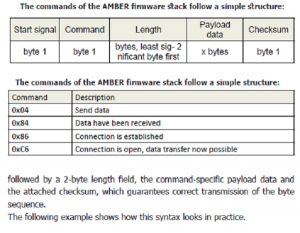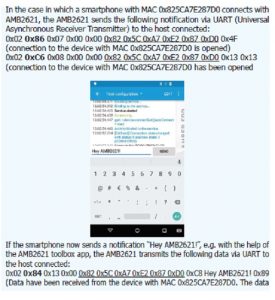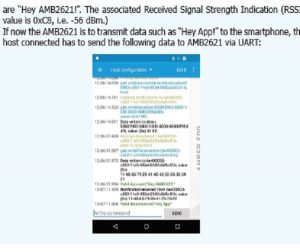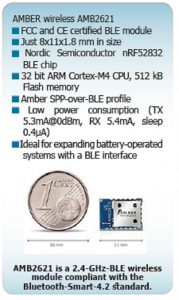Industry 4.0 and IoT rely upon devices networking together. Although the Internet Protocol (IP) and WLAN connectivity are at the forefront of the Internet of Things, there are scenarios in which other techniques have advantages. Bluetooth Low Energy for example.
With its AMB2621 Bluetooth-LE-4.2 module, AMBER wireless, a Würth Elektronik eiSos Group company, opens up new possibilities in the Smart Factory and Smart Home. The main thrust is the use of smartphones or tablet PCs as the user interface for other devices. Bluetooth Low Energy (BLE) offers the perfect basis, as this wireless interface is integrated in modern smart devices as standard and can transmit “small quantities of data” very energy-efficiently. This makes BLE interesting, not only for mains powered industrial machine, but also for battery-powered devices, such as mobile temperature sensors or household devices like smoke detectors, which can be equipped with such an interface. Furthermore, for devices with displays there is the potential to save the display and if required to visualize data on a smartphone or tablet connected over BLE.
Interface configuration
The Smart Factory or the Smart Home rarely originate as green field developments. Intelligent networking of devices and sensors is far more likely to be introduced as an upgrade to existing products and solutions. AMBER wireless therefore paid special attention to easy integration. From its inherent design, AMB2621 has a firmware stack which can be controlled via a serial interface with commands similar to the AT command set. The commands available allow developers to configure the BLE interface for their purposes to allow adjustment of the power and speed of data transmission, as well as the resulting electricity consumption of the respective application. Other commands control connection set-up, data transmission and switching to various power saving modes.
Peripheral Only: Bluetooth as a transparent cable replacement
Operation of the Bluetooth module with command control serves functionality – for example configuration in ongoing operation – and is ideal in terms of safety considerations (checksum). But sometimes the requirements are different.
Alongside operation of the module using commands, there is the “Peripheral Only” mode in such cases. Upgrading of devices is possible thanks to the transparent UART interface, whereby modification of the serial interface is neither desired nor possible. These could be industrial machines with an existing RS232 interface for instance.
The manufacturer Amber wireless intentionally introduced the option of operating the wireless module as ‘Peripheral’ in the sense of the Bluetooth protocol, as this is interesting for very many applications. Devices are equipped with this kind of wireless module so you can connect with them. This means that pairing is initiated by a mobile device. Even without command control that would be necessary to switch off the module that is not required, AMB2621 is particularly power-saving in the “Peripheral Only” operating mode, as the UART interface is only active on establishing a wireless connection. Uncomplicated static passkey pairing is used as a security feature, as in the hands-free car kit. AMB2621 with Peripheral mode is recommended whenever the module does not initiate any connections itself (i.e. it is only contacted from the outside) or no user interface can be implemented, as the rest of the product is already finished.
Bluetooth is the “cable replacement” in this application and communication is correspondingly simple. In the above example, in the “Peripheral Only” mode the host would only receive “Hey AMB2621!” without header and checksum bytes and would only need to send “Hey App!” to the module such that these data are transmitted to the smartphone connected.
BLE possibilities fully exploited
With the Peripheral Only mode, Amber wireless uses a typical function in mobile communications applications for industrial purposes. In another place, the manufacturer purposefully moves away from the common standards. For wireless, AMB2621 offers the “AMBER-SPP-like” profile, which allows transmission of general data between the two connection partners. The Bluetooth Serial Port Profile (SPP) does not actually exist anymore for BLE, which is why AMBER wireless offers its own solution here. Here the optional Bluetooth 4.2 feature “data length extension” (DLE) is used, such that payload sizes up to 243 bytes per Bluetooth packet are possible with the AMB2621. This raises throughput up to 5 kB/s. Familiar pairing methods like JustWorks or StaticPasskey are made available in order to ensure stable data transmission. In the case of StaticPasskey, a 6-digit key has to be entered on a terminal device such that a secure connection can be established. The bonding function, i.e. the use of keys already used for re-authentication, is available in AMB2621.
Further application options
In many cases, the decision between command control of the chip and the Peripheral mode is clearly prescribed by the requirements of the application. However, it is also possible to provide the otherwise firmly soldered pins with a switch for mode selection. This can be useful if the wireless module is normally used for the data request initiated by the mobile device, but is occasionally opened by the device for more complex communication tasks, such as maintenance or configuration tasks.
The module is also capable of all other Bluetooth modes. Broadcasting for example: In place of connection-oriented data transmission, so-called beacons are used to emit power-saving data – the module “sleeps” when it does not transmit. This function is well-suited for battery-operated sensor applications like the periodic transmission of temperature or other environmental data. Distance estimation of a transmitter by means of the RSSI value or position determination by triangulation of several beacons is also conceivable.
Conclusion
Instead of equipping a device with a display, making a smartphone fit for use as a user interface or developing a door control system with a mobile device – these are typical applications that should ideally be run independently of WLAN availability – here Bluetooth is a viable alternative. The wireless module introduced here makes integration especially easy. By the way, samples of AMB2621 and the associated evaluation board AMB2621-EV are available from stock. Field sales engineers are available on-site to provide support in the design-in process and also to elaborate specifications if customer-specific adaptation of the AMBER firmware stack is required.
(box)
AMBER wireless AMB2621
FCC and CE certified BLE module
Just 8x11x1.8 mm in size
Nordic Semiconductor nRF52832 BLE chip
32 bit ARM Cortex-M4 CPU, 512 kB Flash memory
Amber SPP-over-BLE profile
Low power consumption (TX 5.3mA@0dBm, RX 5.4mA, sleep 0.4µA)
Ideal for expanding battery-operated systems with a BLE interface











